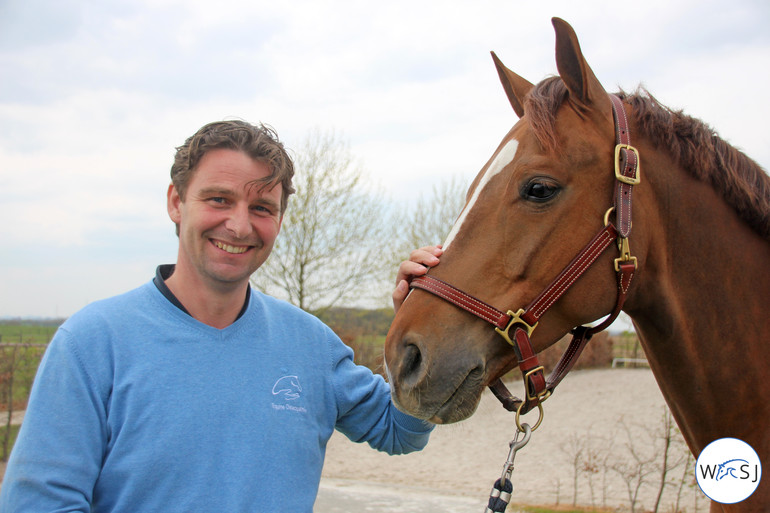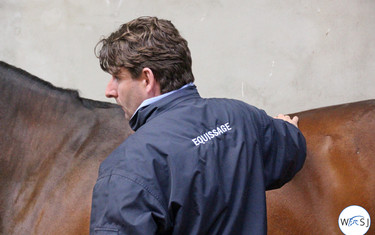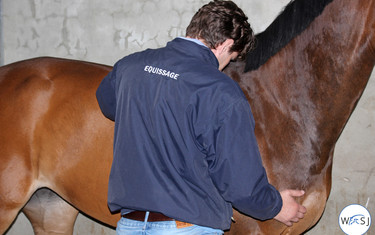He works on assignment for some of the best riders in the world, to help their horses perform to the max. But, ask osteopath Cedric Marie and he will not want to name one of his clients – it’s just not his thing. “I like to help everybody, it does not matter what your name is,” says Cedric to World of Showjumping.
With fifteen years of experience, much of which came under his mentor and tutor Alain Guerland, Cedric is one of the most highly-regarded osteopaths on the international circuit. You will see him in the stables and ring-side at all the major championships, and at most of the big events around the world. “My job is to help the horse to give everything it can back to the rider,” Cedric says. “But, the horse can not give the rider more than the body can and that is where I come in – of course together with the rest of the team such as the groom, vet and blacksmith. In order to get the best result, we must all work together.”
“As an osteopath I try to give the horse the best possible harmony in its entire body,” says Cedric. “When treating the horses, it is just as with humans: It is important to not be too hard or too strong, the horses will react with fear – and as they remember so well it will be hard to work with them again. I work with the horse to get the result that I seek. The horse must feel calm and relaxed before and during the treatment, so that they trust what I am doing and the movements I ask of them.”
“I always think about approaching each horse in the right way,” Marie explains. “Some horses are more anxious and sensitive than others, so it is important that they are calm from the beginning. I want the horse to work with me and want what I ask of them themselves. They have to accept the movement that I am asking for, and they have to give themselves to me. Working with an animal of 600 kg is not about force, if they don’t want to they don’t want to and there is nothing I can do about that,” Cedric continues.
“The first treatment is usually the most difficult, when the horses perhaps don’t understand what you would like them to do. It is important that the first treatment goes well; if I help reducing the problem the horse feels better straight away and will remember the next time I show up – and then it will always be easier to treat.”
The way Cedric works with the horses varies, and depends on whether the horse is at home, is going to a show or actually is at the show. “The work I put into the horse is different at home and at the shows. At the shows it is about helping the horses’ bodies so that they can use themselves to the max. I try to help the horses so they can enjoy the work, making sure that they don’t feel any pain or stiffness. If the horse is stiff or has pain somewhere, and the rider for example makes a short turn and then asks the horse to stretch forwards to the fence there will be a reflex in the horse from that stiffness or pain and it takes out of the performance – it could result in a pole down. Next to that, I also believe that it is important that the horse feels good, happy and relaxed – this contributes to giving the rider the right confidence in the ring. The rider should never have to be insecure about how the horse is feeling,” Cedric says. “At home it is different, there I go deeper into the horses. Perhaps the rider has called me because the horse has a bigger problem, being lame or experiencing other types of pain.”
The problem that Cedric meets most frequently when treating, is back-pain. “The biggest problem I meet is pain in the back, and in the horses’ hind body – such as the pelvis. I treat this a lot of the time. We have to remember that the power in the horses come from behind, so it is vital that they feel good in this part of their bodies. Think how hard they push to jump the big fences they do, and how flexible they have to be – also in the take-off and landing. In one second they must come back and in one second they must come forward. With stiffness or pain they can not, or at least they will not be able to clear the fence they are asked to jump.”
Sometimes the horses have old problems rather than new ones. “The horses also have a history, and sometimes the grooms or riders are not aware of what happened to them in the past. Perhaps the horse fell as a foal, perhaps it had an accident as a youngster. As an osteopath this is something you train and learn to feel, so you can separate what is new and old issues for the horse,” Cedric says. “New problems can come from riding: The rider is not straight, keeps more weight on one side or the other – how you balance yourself has such a big impact on the horse. With some riders, you can see the same problem on several of their horses because of their position on the horse – it reveals you. Then there is of course the saddle, which also will have an impact. But, sometimes the problem can also come from something else than riding – for example something happened in the box or on the transport so it is important to pay attention to the behaviour of the horse.”
On every day basis, Cedrid recommends riders and grooms to check the movements of the horses so they are familiar with it and easily can spot if something is wrong. “Pay attention to the horse being straight and having the same mobility right and left. Every rider should know their horse, and when the feeling is not the same over a few days you should call the vet. Then the vet should also be able to tell you whether it is a problem for him or her, or for an osteopath.”
Cedric also sees a change in the problems that the horses are facing. “Compared to fifteen years ago, the top horses today are much lighter, sometimes also a lot smaller and with a lot more blood than was the case before. The breeding has changed with the sport because today the jumping is also different; the courses ask more and more of the horses and the classes get faster and faster. Before you needed a big, strong and scopey horse for a Grand Prix class. Now they have to be careful, with blood, electric and super quick – but still they have to stay strong in their bodies to remain sound. What I see from my personal experience is that the horses are much more tense than before. This causes them to get more stiff, and with stiffness comes blocks in the bodies,” Cedric explains. “Before you also had less shows then we do today, and the horses did not have to travel so far and so often. It’s a lot for the horses. They have less time to recuperate between their performances, so my job is to help them in between.”
Text and pictures © World of Showjumping by Jannicke Naustdal
(No reproduction without permission)











